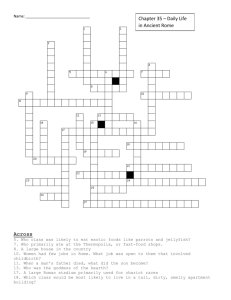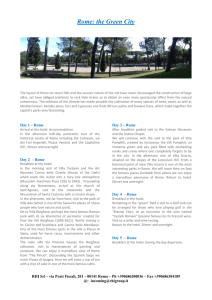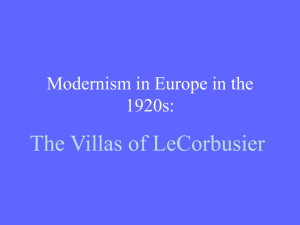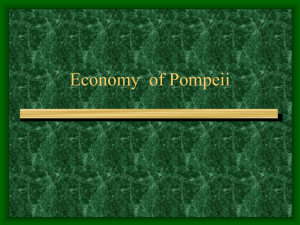PASSAGEWAYS-3-Villa Spada-A Historical Note
advertisement
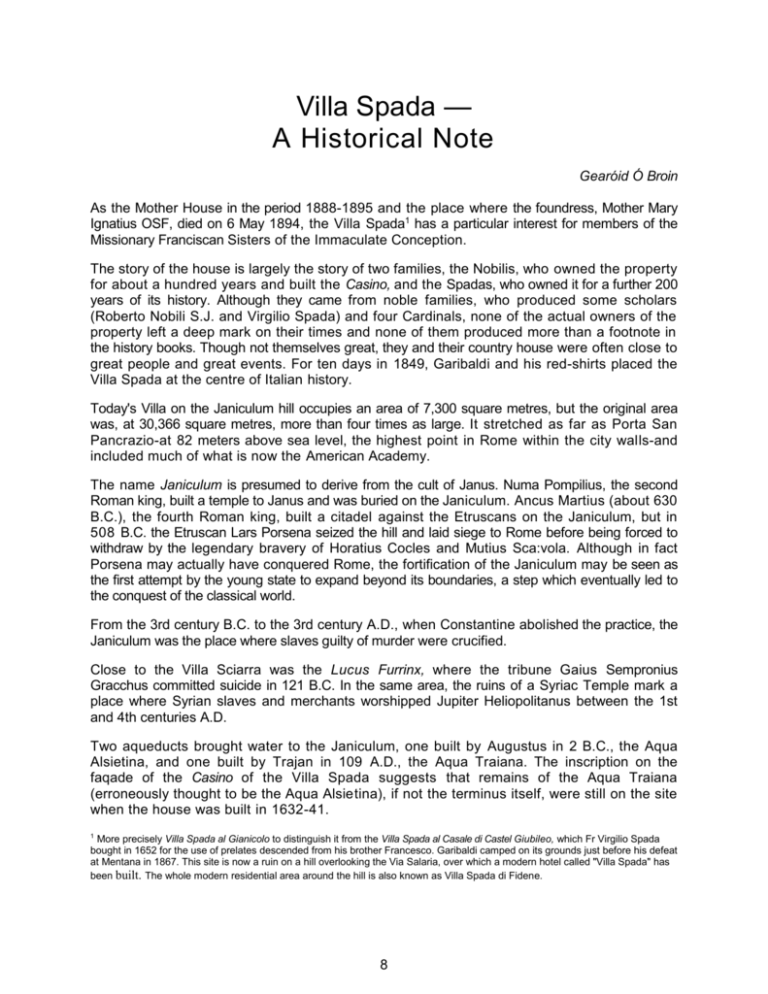
Villa Spada — A Historical Note Gearóid Ó Broin As the Mother House in the period 1888-1895 and the place where the foundress, Mother Mary Ignatius OSF, died on 6 May 1894, the Villa Spada1 has a particular interest for members of the Missionary Franciscan Sisters of the Immaculate Conception. The story of the house is largely the story of two families, the Nobilis, who owned the property for about a hundred years and built the Casino, and the Spadas, who owned it for a further 200 years of its history. Although they came from noble families, who produced some scholars (Roberto Nobili S.J. and Virgilio Spada) and four Cardinals, none of the actual owners of the property left a deep mark on their times and none of them produced more than a footnote in the history books. Though not themselves great, they and their country house were often close to great people and great events. For ten days in 1849, Garibaldi and his red-shirts placed the Villa Spada at the centre of Italian history. Today's Villa on the Janiculum hill occupies an area of 7,300 square metres, but the original area was, at 30,366 square metres, more than four times as large. It stretched as far as Porta San Pancrazio-at 82 meters above sea level, the highest point in Rome within the city walls-and included much of what is now the American Academy. The name Janiculum is presumed to derive from the cult of Janus. Numa Pompilius, the second Roman king, built a temple to Janus and was buried on the Janiculum. Ancus Martius (about 630 B.C.), the fourth Roman king, built a citadel against the Etruscans on the Janiculum, but in 508 B.C. the Etruscan Lars Porsena seized the hill and laid siege to Rome before being forced to withdraw by the legendary bravery of Horatius Cocles and Mutius Sca:vola. Although in fact Porsena may actually have conquered Rome, the fortification of the Janiculum may be seen as the first attempt by the young state to expand beyond its boundaries, a step which eventually led to the conquest of the classical world. From the 3rd century B.C. to the 3rd century A.D., when Constantine abolished the practice, the Janiculum was the place where slaves guilty of murder were crucified. Close to the Villa Sciarra was the Lucus Furrinx, where the tribune Gaius Sempronius Gracchus committed suicide in 121 B.C. In the same area, the ruins of a Syriac Temple mark a place where Syrian slaves and merchants worshipped Jupiter Heliopolitanus between the 1st and 4th centuries A.D. Two aqueducts brought water to the Janiculum, one built by Augustus in 2 B.C., the Aqua Alsietina, and one built by Trajan in 109 A.D., the Aqua Traiana. The inscription on the faqade of the Casino of the Villa Spada suggests that remains of the Aqua Traiana (erroneously thought to be the Aqua Alsietina), if not the terminus itself, were still on the site when the house was built in 1632-41. 1 More precisely Villa Spada al Gianicolo to distinguish it from the Villa Spada al Casale di Castel Giubileo, which Fr Virgilio Spada bought in 1652 for the use of prelates descended from his brother Francesco. Garibaldi camped on its grounds just before his defeat at Mentana in 1867. This site is now a ruin on a hill overlooking the Via Salaria, over which a modern hotel called "Villa Spada" has been built. The whole modern residential area around the hill is also known as Villa Spada di Fidene. 8 Because of the plentiful water supply, the Janiculum became, since the beginning of the 3rd century A.D., a centre of the flour milling industry of such importance that the Aurelian walls were extended to the Janiculum in order to protect it. The milling industry came to an end after the Ostrogoth king Witigis cut the aqueducts in 537 A.D. in a vain effort to drive the Byzantine general Belisarius out of Rome. In 1607-1610, Pope Paul V rebuilt the Aqua Traiana using existing arches where possible. This aqueduct, now known as the Acqua Paola, terminates in the Fontana Paola. Traces of the two aqueducts have been found in the grounds of the American Academy and in the grounds of the Sisters of Our Lady of Sion, where the Aqua Alsietina seems to have terminated. From the time of the early Renaissance, the great Roman families lived in palazzi in the city centre, while also owning property outside the city, preferably on a height, where they could escape from the summer heat. The term Villa Spada thus denotes a property in the country with cultivated land and a house belonging to the Spada family. The actual house is usually referred to as the Casino, Villino, or Casale di Villa Spada. This revived a tradition going back to antiquity. The ancient Roman gardens of Scipio Africanus (236-183 B.C.), Lucullus (ca. 106-57 B.C.), Sallust (8635 B.C.) and Maecenas (70-8 B.C.) were particularly famous. The gardens, which Julius Caesar left to the people of Rome, included the area of the Villa Spada and Villa Sciarra down to where the Trastevere railway station is today. Within Caesar's gardens, there was a Temple dedicated to the goddess Fortune and a luxury villa where Caesar entertained Cleopatra. After the fall of the Western Empire, much of the life of the classical period continued but the era of Rome as a cosmopolitan centre came to an end. Before 475 A.D., objects from all parts of the Empire are found in excavations in Rome but after that date only objects of local manufacture are found. The population shrank and concentrated in the city centre. The great gardens on the periphery from classical times were taken over by the Church, converted to food production or returned to nature. The earliest maps of Rome show the church and monastery of San Pietro in Montorio as the only significant construction on the Janiculum. Few buildings were added before the last quarter of the 19th century. In the immediate vicinity of the Villa Spada, the only other buildings of note were the monastery and basilica of San Pancrazio (c. 500 A.D.), Villa Lante (1524), Villa Sciarra (late 16th century), Fontana Paola (1612), and the Villa Farnese, later, Villa Savorelli and now Villa Aurelia (1645-55). Some other notable buildings in the area destroyed in the fighting of 1849 included the Casino dei Quattro Venti, Villa Medici del Vascello, and Villa Malvasia. The first known owners of the property were the Nobili family, first found in Orvieto where Manente was governor in the year 1017, having come to Italy with Otto In, the German King and Holy Roman Emperor, who ruled from Rome at the end of the 10th century. In 1460, Guido di Giovanni moved to Montepulciano and his son Roberto married Lodovica Del Monte, sister of the future Pope Julius III, who reigned from 1550 to 1555. In 1551, their son, Vincenzo Nobili (15151560), commanded the Pontifical cavalry in Pope Julius' unsuccessful war against Parma and Mirandola. In 1554, he commanded the Tuscan infantry in the war against Siena. Later that year, he retired to his home in Montepulciano. The main square in Montepulciano is enclosed on two sides by the Cathedral and municipal buildings, and on the other two by the Palazzo Del Monte built by Antonio da Sangallo in 1519 and the Palazzo Nobili at right angles to it. This arrangement underlines the closeness of the Nobili and Del Monte families and their prominence in the town. 9 The Nobili family produced two noted churchmen. Roberto Nobili (1541 1558), son of Vincenzo, was made a Cardinal at the age of 12 by his grand-uncle Julius III in 1553. Julius' successor, Paul IV, appointed him Vatican librarian in 1555. He was a scholarly youth, given to fasting and other penitential practices and considered a saint by Saints Charles Borromeo and Robert Bellarmine. He was buried with his grand-uncle, Cardinal Antonio Del Monte, in the Del Monte chapel built by Pope Julius III in the church of S. Pietro in Montorio. A brother of the Cardinal's, Pier Francesco Nobili (1548-1592), fought at the battle of Lepanto under his brother-in-law, Sforza Sforza. He is the first known owner of the property that later became the Villa Spada, having bought it late in the 16th century for 2,000 scudi. Roberto Nobili S.J. (1577-1656) was born in Montepulciano, the eldest son of Pier Francesco Nobili, but renounced his title in favour of his younger brother, Vincenzo, in order to spend his life as a missionary in India. He acquired an understanding of Indian culture unsurpassed for centuries and, despite difficulties with his superiors, who did not understand his experiments in inculturation, he was a spectacularly successful missionary who left behind 40,000 converts on his death. Vincenzo Nobili (1589-1649), brother of the missionary, built the Casino and radically transformed the property. In 1647, he added the chapel of St Francis to the church of S. Bernardo alle Terme. His widow, Leonora Orsini, left us his bust together with the busts of four other members of the family in that chapel. The church itself had been built in 1598-1603 by Caterina Nobili Sforza (1535-1605), a niece of Julius III and sister of the Cardinal. Sforza Sforza, Caterina's husband, was one of the foremost military. commanders of his age. At the battle of Lepanto, he was aboard the flagship as general of the Spanish infantry and adviser to Don John of Austria. Their daughter, Costanza, born in 1559, married Giacomo Boncompagni (1548-1612), son of Pope Gregory XIII (1502-1585). Their son, Francesco Sforza (15621624), became a Cardinal in 1583. At the time when the house was built, the population of Rome was just over 100,000. The period was one of intense artistic activity in the city. The architect of the Villa Nobili (later Villa Spada) up to his death in 1641 was Francesco Peparelli and, later, his pupil Giovanni Antonio De Rossi (1616-1695). The building of the house is commemorated by a Latin inscription on the facade, which in translation reads: Villa Nobilia: Traveller, be not unaware that here where you behold the house built by Vincenzo Nobili in pleasant surroundings to delight men's minds Augustus Caesar constructed the water outlet called by his name and drawn from Lake Alsiatinus at the 14th milestone and brought to the region of Trastevere. I have spoken. Go happily on your way and farewell. AD 1639. The device of an eagle can be seen on the ceiling of the salon, on either side of the central window in the facade, and at each of the outside four corners of the house. The same device can be seen surmounting each of the Nobili busts in the church of San Bernardo alle Terme. The Villa faces towards the Alban Hills but the view is now largely obscured by trees and later constructions. Vincenzo Nobili may have been encouraged to adopt this orientation by an action taken against him by the friars of San Pietro in Montorio, who succeeded in making him agree not to have windows overlooking their garden. 10 Roberto Nobili, Vincenzo's son, who sold the Villa Nobili to the Spada family, died in 1713. Although he married twice, he left no heir. The Spada family claimed descent from Alerano Artesino, who around the year 967 followed a military career in Gubbio, whence the surname. An inscription in the Spada Chapel in the church of San Girolamo della Carita commemorates three Spada brothers, who saved St Francis of Assisi from thieves and gave him hospitality in their house in Gubbio in 1206. Another inscription commemorates Blessed Guido Spada OFM, who died in Bologna in 1306. In 1353, Cecco Spada (a direct ancestor of the Spadas of Rome) was forced by the Guelf party to move to the Ghibelline town of Forlimpopoli. The family later moved to Bologna when Forlimpopoli was destroyed by Cardinal Albornoz, who re-conquered the Papal States in 1353-1366 in preparation for the return of the Pope from Avignon. Giacomo Spada (1502-1566) was Governor of Brisighella and Counsellor of State under Pope Pius V His son, Paolo Spada (1541-163 1), was treasurer of Romagna and became extremely wealthy, with a great deal of real estate in Romagna and in Rome and a considerable income from investments and lettings. He had a passion for building but little competence in architecture. Giacomo Filippo (1576-1636), Paolo's son by his first wife, founded the Faenza branch of the family. Paolo hoped that his children by his second wife would found a Roman branch of the family. As the more competent of the sons of this marriage, Bernardino (15941661) and Virgilio (1596-1662) had opted for the Church, Paolo's hopes reposed in Francesco (1593-1643). However, Francesco was impulsive and had little business sense. He ran away from home at 16 to marry. When his wife died in 1627, he left to fight in Flanders. He quarrelled with everyone, including his son Orazio. He eventually reached high military and civil positions in Ferrara. Bernardino became Nuncio to France in 1624-1627, Cardinal in 1626, and Papal Legate in Bologna (1627-1630), where he showed great courage and ability in facing famine and plague. He retired to Rome in November 1631. On his death, he left 25,000 scudi for charity. In 1632, he purchased as his principal residence the Palazzo Capodiferro for 31,500 scudi. This had been built in 1550 by Cardinal Capodiferro, a predecessor of his as Nuncio to France and an intimate friend of Pope Julius III. Cardinal Bernardino Spada inherited from his father a passion for architectural tinkering to little purpose. In the 28 years in which he lived in Palazzo Spada, he spent a further 55,000 scudi on various works, frequently changing his mind and undoing previous work. He employed a great variety of artists including Bernini and Borromini. He particularly liked trompe Z'cril and called to Rome specialists in this whom he had known in Bologna, such as Girolamo Curti (il Dentone) and Angelo Michele Colonna. The courtyard of the Palazzo Spada by Giulio Mazzoni is the most ornate courtyard in Rome. Palazzo Spada was rented by the Italian State as the headquarters of the Council of State in 1889, and was purchased by the State in 1926. The Palazzo also houses the Galleria Spada, which contains works of art which were in the Palazzo when Cardinal Bernardino bought it, works which Maria Veralli brought with her when she married Orazio Spada and some purchased by the Cardinal. The collection includes portraits of the Cardinal by Guido Reni and Guercino. The Cardinal's heir was his brother, Fr Virgilio Spada (1596-1662), who became head of the Congregation of the Oratory in 1656. He was a self-taught architect and close friend of Francesco Borromini. He became the private architect of Pope Innocent X and supervised 11 the 1646-66 restoration of the Basilica of St John Lateran and the construction of a prison in Via Giulia. He drew up the first proposal for the layout of Piazza S. Pietro, a project later taken up by Fontana. In 1654-1660, Fr Virgilio designed the Spada Chapel in the church of S. Girolamo della Carita, one of the masterpieces of Roman baroque. He received advice from Borromini, and from other architects such as Pietro da Cortona and Giulio Buratti. The fact that the chapel was long thought to be Borromini's masterpiece is a tribute to Virgilio's competence. His nephew, Orazio, built the Spada Chapel in the church of Santa Maria in Vallicella (Chiesa Nuova) in 1663-1679. All three Spada Cardinals, Bernardino, Fabrizio (1643-1717), and Alessandro (1787-1843), are buried there. Francesco's son, Orazio (1613-1687), inherited Palazzo Spada from Fr Virgilio. He received from his wife, Maria Veralli, whom he married in 1635, a dowry of 31,500 scudi, together with the fief of Castel Viscardo, on which Urban VIII conferred the title of Marchese. This estate covered 1,000 ha. and was worth 75,000 scudi. Maria's inheritance also included a palazzo in Rome opposite the church of San Carlo worth 10,000 scudi, and Palazzo Veralli at Piazza Colonna, which remained in the Spada Veralli family until 1819. It was demolished in 1889, and in 1922 the Galleria Colonna was built on the site. The daily life of Cardinal Bernardino, Fr Virgilio, and Orazio can be reconstructed practically on a daily basis from the voluminous correspondence which they have left behind. Orazio had considerable entrepreneurial ability, unusual among Roman nobles of the time. He conducted many agricultural experiments at Castel Viscardo, including fish-farming and the introduction of Chianti grapes. He lived the life of a country gentleman, writing detailed letters to Maria in Rome describing his journeys and activities in Castel Viscardo, the well-being of his twelve surviving children, and his investments in Rome and the countryside. A daughter of his was married in Viterbo to a nephew of the infamous Donna Olimpia Maidalchini, sister-in-law of Innocent X. Orazio usually stayed with the Maidalchinis in Viterbo on his way. The journey took the best part of a day and was full of dangers from highwaymen, so that it was necessary to travel accompanied by armed servants. Orazio's son, Bernardino Spada Veralli (1638-1716), did not show the same attention to business as his father. With him, the process of accumulation characteristic of Paolo, Cardinal Bernardino, and Orazio came to a sudden end. Under his management, the estate began to go into a decline, which the addition of inheritances and dowries was not sufficient to halt. By the late 19th century, the family was only moderately well off. Bernardino sold a number of properties, although he did make one purchase: he bought the Villa Nobili on 7 March 1689 for 9,200 scudi from Marchese Roberto Nobili. A considerable amount of work was done on the house and gardens, much of it paid for by Cardinal Fabrizio Spada Veralli. Bernardino's son, Clemente Spada Veralli (1679-1759), was a meticulous character. In 1700, his wife, Maria Pulcheria Rocci, brought him a dowry of 30,000 scudi. However, the run-down of the property continued. The cost of marrying his three daughters was a further drain on the estate. As he had no surviving sons, Clemente, in accordance with the terms of Fr Virgilio Spada's will, left his titles and property to his half-third cousin twice removed, Giuseppe Spada Bonaccorsi (1752-1840) of the Faenza branch, a descendant of Paolo Spada and his first wife. In 1763, Pope Clement XIII authorized him to use the Spada Veralli surname and coat of arms. His title of Marchese was changed at his own request to that of Prince of Castel Viscardo by Pius VI in 1777 on the occasion of his marriage to Giacinta Ruspoli, daughter of Alessandro of the family of the Princes of Cerveteri. 12 In 1798, when the French were reorganizing much of Italy, Prince Giuseppe Spada was one of a group of aristocrats who espoused republicanism and welcomed the new order. The French occupied Rome on 11 February 1798 and on the same day, with the agreement of General Berthier, Prince Giuseppe Spada was appointed a member of the Congregation of State together with three Cardinals and two other laymen, all considered favourable to the French. As Citizen Spada, he commanded the national guard in the period February June 1798. He became a Senator of Rome and was appointed to the French Senate in the Palais Luxembourg. Although Giuseppe lived in Rome, his attention was fixed on Bologna, where his heir, Clemente, was born the year after his marriage. He bought the Palazzo Zagnoni in Bologna in 1802 and transferred there with his family in that year. Clemente Spada Veralli (1778-1866) had a great interest in agriculture and new experiments. He transferred his experience in Romagna to Castel Viscardo, where he introduced the cultivation of the silkworm. In the Bologna area, Clemente showed interest in problems of public education and in the first railways in the Papal States. After the assassination of his Prime Minister, Pellegrino Rossi, on 15 November 1848, popular demonstrations forced Pope Pius IX to flee to Gaeta and call on Austria, Spain, and France to restore his authority. Elected representatives declared a Republic in Rome headed by Giuseppe Mazzini. On 25 April 1849, a French force under General Oudinot (1791-1863) landed at Civitavecchia and advanced on Rome along the Via Aurelia. The Republican authorities gave Garibaldi the defense of the high ground overlooking Porta San Pancrazio. His first headquarters was in the Villa Corsini outside the walls. Convinced that they would meet no resistance, the French marched on Rome on 30 April, but they were repulsed by Garibaldi at Porta Cavalleggeri.2 The French then made preparations to take the high ground of the Janiculum, which would enable them to dominate the city. To do this, it was first necessary to take the Villa Corsini, since the ground there was level and would permit them to dig siege trenches for their counter-batteries. Once this operation had begun, success was only a question of time. Oudinot attacked on 3 June, taking Villa Pamphili and Villa Corsini. Garibaldi sent waves of small groups against the entrenched French position throughout the day. His losses were huge and included Angelo Masina, Enrico Dandolo, and Goffredo Mameli. Mameli was taken to the Trinita dei Pellegrini hospital beside the Palazzo Spada, where the wounded were treated, and died there. He is buried in the monument to those who died for Rome in the little park between the Villa Spada and San Pietro in Montorio. This battle marked the end of any hope for the Republic. The French began a month of incessant shelling of the city, causing huge damage to buildings. Garibaldi now made his headquarters in the Villa Savorelli, just inside the Urbanian walls and the highest point in the sector. On 21 June, the French captured a bastion on the walls, forcing him to fall back to the line of the Aurelian walls with the Villa Spada as his headquarters. When Garibaldi's wife Anita heard of Oudinot's attack of 30 June, she left Nice for Rome, although she was five months pregnant. She reached Rome on 26 June and joined Garibaldi just as he was having breakfast in the Villa Spada. There was hand-to-hand fighting until the French made their final assault at one o'clock on the morning of 30 June. The Villa Spada under Garibaldi's chief of staff, Luciano Manara, was surrounded and Manara was fatally wounded, when he showed himself from a top-floor window while directing operations. 2 This victory is commemorated in the name of the street, Viale XXX Aprile, which runs along one side of the Villa Spada. 13 After the fall of the Villa Spada, the Republican leaders decided that further resistance was futile. On 3 July, the French occupied Rome, allowing the Republicans to leave. Pope Pius IX returned to Rome in April 1850, escorted by French troops. Over 500 of the defenders of the Republic had been killed. Garibaldi's heroic defense of Rome created a powerful legend, which became an essential element in the Italian national myth. Although the Villa Spada suffered extensive damage in the fighting, the main structure remained intact and it was quickly repaired according to the original design. Clemente's son Vincenzo (1821-1855) married Lucrezia Fieschi Ravaschieri, and their children, Federico Augusto (1847-1921), Maria (1853-1902), and Olga Spada Veralli e Ravaschieri, all born in Bologna, were the last of the Spada Veralli name. Federico reputedly fell in love with a commoner but could not marry her because of family opposition. He refused to marry anyone else and became eccentric. He lived in Naples but dressed in rags but paid his bills in taverns with a large tip, saying: "Prince Spada does not take change." Once in a Naples hotel, he flooded an apartment in order to paddle about in it. As his sole means of communicating was through lengthy and costly telegrams, he had telegraphic equipment installed in the post office of Castel Viscardo, the first one in the Orvieto district to have such equipment. Castel Viscardo was given as a dowry to his sister Olga when she married Astorre Benedetti, Duke of Montevecchio. This property is still owned by their descendants. On 17 November 1878, Federico sold the Villa Spada to a banker, Roberto Wedekind, for Lire 190,000. On 11 January 1885, Paolo Wedekind sold it for Lire 225,000 to Maffeo Barberini Colonna di Sciarra (1850-1925), who had been renting the property since 1872. Don Maffeo was a prominent figure in social, literary, and artistic circles in the last quarter of the 19th century. He lived in the Palazzo Sciarra in Rome. He already owned the Villa Sciarra and had extensive land holdings outside Rome. In 1882, Don Maffeo was elected to Parliament. In 1884-90, he assumed responsibility for the troubled opposition newspaper La Tribuna, and made it into one of the most important political newspapers in Italy. Because of his use of the telegraph and excellent correspondents and an editorial team, which included Gabriele D'Annunzio (1863-1938), Don Maffeo is considered the initiator of modern journalism in Rome. He spent lavishly on editorial and printing premises for La Tribuna. He founded Rivista politica e letteraria and financed D'Annunzio's periodical Cronaca bizantina. He published at his own expense D'Annunzio's Isaotta Guttalauro e altre poesie in 1886. He also opened the first popular theatre in Rome, the Teatro Quirino, on his own property in the city centre. A convention between the Government and the Comune of Rome, whereby the Government made available a sum of Lire 50 million for the enlargement of the new capital of Italy, set off a wave of speculation in building land. The construction of the Ponte Garibaldi in 1888 and the opening of Via Arenula and Viale di Trastevere made the Janiculum more accessible and increased substantially the value of building land there. Don Maffeo was active in selling building sites, often to unscrupulous developers who destroyed existing historic structureshouses, Aurelian walls, and remains of Roman aqueducts-which interfered with their plans. Don Maffeo was badly hit by the recession of 1887. This was just before he rented the Villa Spada to Mother Ignatius. Because of the acrimonious court case which followed a dispute over the terms of the lease, Don Maffeo has received a bad press from the historians of the Congregation. It seems that his financial difficulties led him to attempt to sell the Villa to the Sisters, for Lire 700,000, far more than it was worth. 14 Ill-advised speculation, such as a drainage scheme in the upper Tiber valley and a scheme to save the equine strains of the Roman countryside, combined with his legendary extravagance, eventually led Don Maffeo to economic ruin. Don Maffeo and the Compagnia Fondiaria Italiana owned much of the property on the Janiculum, and in 1886 agreed a project for its division into lots for urban development with the municipality. In 1892, 1896, and 1897, the Bank of Italy obtained ownership. Part of it, including the present Villa Sciarra and Villa Spada, was sold, and the remainder went in 1905 to a company which sold lots to various individuals and companies. The Banca Romana, one of six banks authorized to issue legal-tender banknotes, took advantage of the property speculation in the early 1890s by extending excessive credit to the building industry. As a result, the Bank issued notes which exceeded the legal limit by Lire 65 million, including Lire 40 million of false currency issued with duplicated serial numbers. Much of this excess went in loans to politicians. The resulting scandal led to the establishment of the Bank of Italy in 1893. Don Maffeo was linked in a small way to the scandal, when a parliamentary commission censured him together with some other deputies. He left Rome for Paris and later retired to Frascati. In accordance with the terms of their lease, the Sisters had the present perimeter wall built along Viale XXX Aprile, Via G. Medici, and the park containing the Monument to those who died for Rome. On 10 August 1903, Prince Federico Spada Veralli bought back the Villa and, on his death in 1925, it passed to Prince Ludovico Spada Potenziani (1880-1971), who served as Governor of Rome in 1926-28 and Senator. His name is recorded on a number of public buildings from the period (e.g., the interior of Rome Opera House). Ludovico's father was Giovanni Antonio Grabinski (1850-1899), son of Sofia Potenziani, the last of that family, who had married Enrico Grabinski, son of Gioacchino Giuseppe Grabinski (1767-1843), a Polish nobleman who became a Napoleonic general and settled in Bologna. Giovanni Antonio was created Prince Potenziani by Pope Leo XIII in 1884 and by King Umberto I in 1891. He served as a Senator of the Kingdom of Italy and, in 1875, married Prince Federico's eldest sister, Maria Spada Veralli e Ravaschieri (18531901). As the male agnation of the Spada Veralli family had become extinct on the death of Federico in 1921, Ludovico was given royal authorisation in 1926 to prefix the Spada surname to that of Potenziani. Ludovico's daughter Myriam (1903-1961) was granted the right of succession for male descendants by royal decree of 1929. She does not appear to have married, however. In 1925, the Villa Spada was bought for $200,000 in dollars by Contessa Nora Khuen (nee Lutzow), who sold it in January 1937 to Valentina Amelia Fernanda Esmond (nee Deutsch de la Meurthe). In March 1937, she donated the Villa to her daughter Sybil Yvonne Uzielli (nee Esmond). In 1938-9, her husband, Giorgio Uzielli, expended much energy in furnishings and in landscaping the gardens, including the installation of the swimming pool. He also added a major extension wing to the house. In 1941, the Uziellis were in the US and advertised the Villa for sale at $200,000. In 1946, the Government of Ireland bought it for $150,000. On 23 June 1937, the Villa Spada was declared to be of considerable public interest. No changes may be made to the structure of the buildings internally or externally or to the gardens without the permission of the Italian authorities. Until the present century, the Villa was never the principal residence of any of its owners. From 1632 to 1802, the Spadas lived in the well-known Palazzo Spada in Piazza Capo di Ferro and 15 thereafter in Bologna. The Nobilis on the other hand do not seem to have had a fixed Roman abode. Vincenzo lived near Piazza Fiammetta and Roberto near Piazza del Gesu. Besides the Casino, there was also a cottage on the property. The earliest parish records in 1685 show that a gardener living on the property, then described as "Giardino del S. Marchese Nobili". A vine-dresser was there in 1677 but the property was vacant in 1676. There is a gap in the records until 1729, when a peasant (villicus) is shown as living on the property (now the Villa Spada). The records suggest that members of a single family, sometimes accompanied by additional workmen, rented the property for most of the period of ownership by Spadas. Before the Casino was built, the property was rented for 100 to 120 scudi a year. Before he died, Vincenzo was able to rent it to the Duke of Acquasparta for 500 scudi. In 1651, Vincenzo's widow, Eleonora Orsini, rented the property to Cardinal Bernardino Spada, the beginning of the Spada family's long association with the place. In the early 18th century, the Casino was used by Bernardino Spada Veralli's brother, Cardinal Fabrizio Spada Veralli, who spent a considerable sum on works in the house and garden. It was later rented to another relative, Ciriaco Spada, for only 100 scudi a year. Bernardino's son Clemente also used it as a country retreat. The last parish records of 1877 mention an unnamed non-Catholic foreigner with two domestic servants and a coachman. Thus, although the house is an impressive baroque building, at the time when it was built and for long afterwards, it was seen by its owners as a modest house at the centre of a pleasure-garden and vineyard in the country, of little importance compared to their more stately and centrally located principal residences, whether in Montepulciano, Brisighella, Rome, or Bologna. The Nobili and Spada families came from outside Rome, from Montepulciano and the Romagna. Neither ever really settled in Rome: only Bernardino II and Clemente I Spada Veralli were born there. Their predecessors came from Brisighella and their successors from Bologna. Ludovico was born in Rieti and, after his Governorate of Rome, he took to banking in Rieti. It was the Del Montes' prominence in the Church that brought the Nobili family to Rome, and Bernardino's Church career that brought the Spadas there a century later. The Government of Ireland chose the Villa as its base for developing relations with the Holy See. Hence there is a certain irony in the fact that when, for a brief nine days in 1849, the house itself was almost a protagonist in the main event of the time, it should be in hostility to the Holy See as the last citadel of a movement which had driven the Pope from Rome. It was fortunate to emerge from that conflict still standing. AUTHOR: Gearóid Ó Broin, Ambassador of Ireland to the Holy See at the time of the publication of PASSAGEWAYS in 1995, was born in County Cork on May 21, 1940. Following his graduation from University College, Cork, he entered the Department of Finance. In 1964 he joined the Department of External Affairs and there followed a distinguished career in diplomatic circles: Appointed Ambassador to the Holy See in 1991. and occupying the Villa Spada during that time, he and his wife Roberta Cordero di Montezemolo, whom he married in 1968, were host and hostess to the entire community at Rome during the centennial celebrations on May 8, 1994. To mark the special event, Ambassador Ó Broin gave permission for the erection of a commemorative plaque in the chapel of the Villa, which was unveiled by Sister Marian Bandille, General Minister, during the special ceremony held at the Villa Spada. 16


